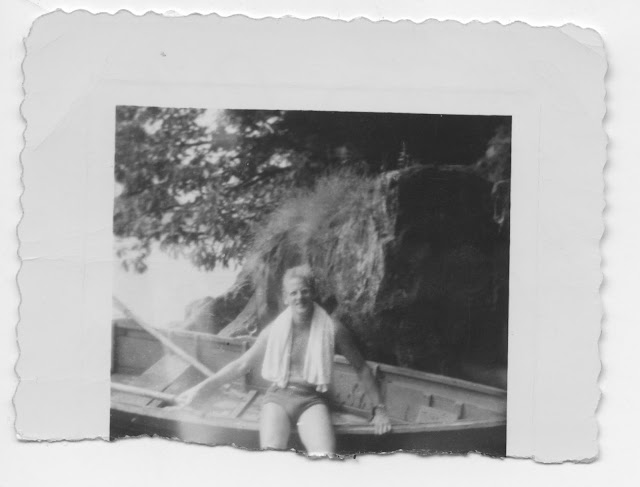 |
| The approach to St. John's in 1813, by Chappell. |
Dale Jarvis, Heritage NL
I love placenames, and over the past decade of intangible cultural heritage work, local names for places come up time and time again in our discussions of local history. Sometimes those discussions of toponymy pop up in unlikely contexts.
Earlier today, an online discussion of the word “lazaretto” - an isolation hospital for people with infectious diseases, especially leprosy or plague, or a building/ship used for quarantine - included a reference to quarantine procedures on Signal Hill in this quote from the Evening Telegram (St. John's, N.L.) of 1892-09-30:
There is access to it by water and on two sides by land, by a path from the lazaretto, which can be made good enough for a horse at the expense of ten dollars, and by a road from Chain Rock, which is not finished yet.
That quote raised the following question from Twitter user Rick Magill:
I always assumed chain rock got its name during WWII when they had torpedo/sub curtains across the narrows. Clearly much older. Anyone know how and why it got its name?
Historian Dr. Heidi Coombs was quick to respond, stating:
They referred to Chain Rock during the 1832 cholera quarantine, so it’s at least that old. Ships were not permitted to proceed into the harbour beyond Chain Rock.
She also shared the proclamation requiring ships to anchor at "the first Buoy within Chain Rock," from the Colonial Secretary's Office -- Quarantine Letters, 1832-26 (GN 2/17) at The Rooms.
Going back a bit further, we find a reference to Chain Rock in the long-titled work “Voyage of His Majesty's Ship Rosamond to Newfoundland and the Southern Coast of Labrador: Of which Countries No Account Has Been Published by Any British Traveller Since the Reign of Queen Elizabeth,” by Edward Chappell and published by J. Mawman in 1818.
In February of 1813, His Majesty's ship Rosamond, commanded by Captain Donald Campbell with Edward Chappell as his Lieutenant, received orders from the Admiralty. They were to repair forthwith to Cork, Ireland, in order to collect the first spring convoy bound for Newfoundland, Halifax, and the St. Lawrence River. This, they did, arriving first at Cape Broyle, and then heading to St. John’s. Of their entrance into the port, Chappell wrote,
At about two-thirds of the distance between the entrance and what may properly be termed the harbour itself, there lies a dangerous shelf called Chain Rock; so named from a chain which extends across the street at that place, to prevent the admission of any hostile fleet. Mariners, on entering this place, ought to be aware of approaching too near the rocks beneath the light-house point. At the time we sailed by them, the masts of a large ship were still visible above the water, that had a short time before been forced by the swell upon those rocks, where she immediately foundered.
By 1813, the name Chain Rock was already well-established Historian Paul O’Neill summarized one version of history of the Rock in his book The Oldest City, published in 1975. He writes,
About 1770 a heavy chain was stretched across the Narrows from Chain Rock to Pancake Rock, and it was the duty of the troops to raise this chain each evening so that an enemy vessel or privateer could not sneak into the harbour under cover of darkness. During World War I a chain boom was again put into use. In World War II the Narrows were protected by a series of metal mesh anti-submarine nets.
1770, however, is not the oldest reference to Chain Rock. Former Parks Canada historian James Candow, in his book “The Lookout: A History of Signal Hill,” notes that a plan of St. John’s Harbour from 1751 includes the placename. He writes,
The same 1751 plan includes an early use of ‘Chain Rock’ to denote the navigational hazzard in front of the old North Battery site, and to which the chain of the Narrows boom had been affixed earlier in the century. [emphasis mine]
Archaeologist Steve Hull of the Provincial Archaeology Office pointed out an even earlier possible date.
This map, "Plan du port et du fort de Saint Jean en l'Isle de Terreneuve, 1726" shows a chain across at least part of the mouth of the Harbour (see detail below).
The map key in the upper-right records R as follows:
"la chaîne qui empêche l'entrée aux vaisseaux" - the chain that prevents entry to vessels.
So, the name Chain Rock goes back at least to the early 18th century. An earlier map of the harbour, drawn by David Southwood in 1675, notes the locations of both North Fort and South Fort, but not Chain Rock. Any use of the name earlier than the 1700s would, for now, be based on speculation. A research project for a future placenames researcher!
Local folklore aside, the name is definitely, and dramatically, older than the submarine nets of WWII.
Want to know more about NL archaeology and history? You can read Dr. Amanda Crompton's report on her 2008 fieldwork around Signal Hill, which included work near Chain Rock, starting on page 21 of the PAO Report.
















